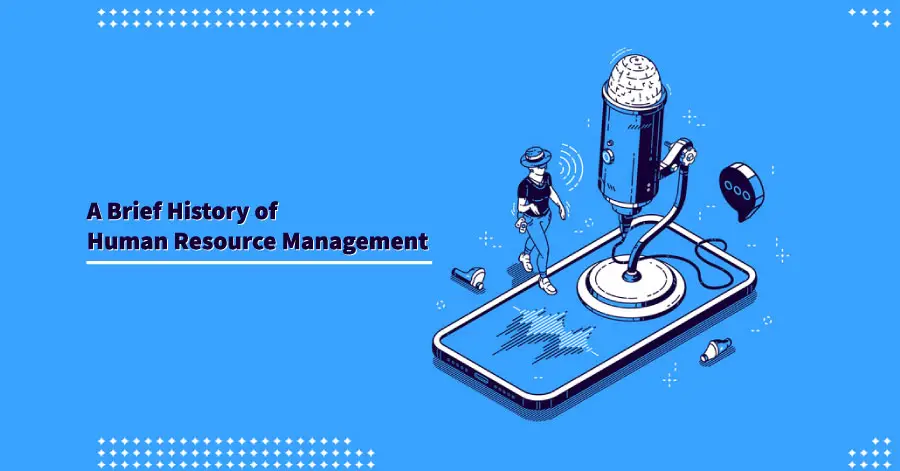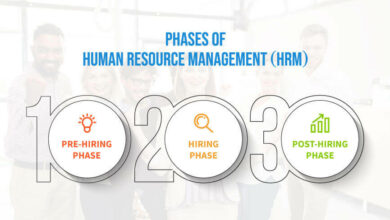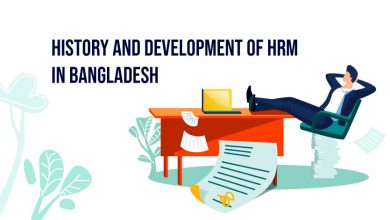A Brief History of Human Resource Management (HRM)
The main intention of achieving HRM is to develop a different type of ability to do something successfully. For example knowledge, skills, attitudes, managerial areas, technical areas, conceptual areas, human and behavioral relations areas. This article will be given a decent discussion about a brief history of human resource management (HRM) so that beneficiaries be more helped by our blog. Let’s go to the main topic.
A Brief History of Human Resource Management:
According to French, modern Human Resource Management (HRM) has emerged from nine interrelated sources. Through these nine sources, a brief history of human resource management has been developed. However, let’s see those nine sources. Such as-
- The rapid technological change increased the specialization of labor associated with the Industrial Revolution.
- The emergence of free collective bargaining with constraints established for unions and employers.
- The scientific management movement.
- Early industrial psychology.
- Government employees practice outside the establishment of the Service Commission.
- The emergence of staff specialists and the grouping of these specialist staff departments.
- The human relations movement.
- The behavioral sciences.
- The social legislation and court decisions of the 1960s and 1970s. Let us consider each.
The Industrial Revolution’s three characteristics were the development of machinery, the linking of human power to machines, and the establishment of factories in which a large number of people were employed. The result was a tremendous increase in job specialization as well as in the number of goods that workers could produce. The “division of labor” became the critical cry of this revolution. Listen, Adam Smith, writing in his book Wealth of Nations, describes the division of labor in a pin factory.
Charles Babbage, writing in his On the Economy of Machinery and Manufactures, noted the principal advantages of this division of labor – The training of new employees was significantly reduced because only one job was required to be learned. Nevertheless, Adam Smith has noticed the demerits of this division of labor. Similarly, Karl Marx emphasized the psychological consequences of capitalism and the division of labor. Capitalists treat a worker in exactly the same way as they open one machine and connect it to another. As a result, the worker began to develop hatred instead of being attracted to his work. They deprive him of the intellectual potential of the labor process.

Owen’s Experiments:
Singled out for special attack by Owen were practices children, such as beating seeming laggards and 6:0 AM to 8:0 PM working days and saw these leading eventually to serious problems, such as empty minds and alcoholism. Owen’s special concern for hours, safer working conditions housing for the apprentices in his employ. He even attempted to reform the New Lanark, including the rebuilding of houses, improving sanitation, and cleaning the village streets at company expense.
In addition to this improvement in human management, Owen also established what the earliest performance appraisal system was probably. He did this as a check on “inferior conduct.” A block of wood, with four different sides, painted white, yellow, blue, and black, was mounted on each machine. Each day the appropriate color was turned to the aisle to reflect each employee’s previous day’s production. Black meant bad, blue meant different (average), yellow meant well, and white meant excellent. This practice was extremely successful, but Owen did not have any other efforts. For example, the promise of a special holiday in summer was not an adequate inducement to all employees to come to work on New Year’s Day and to give up the day’s libations.”
Owen’s experiments contributed to the profitability of New Lanark’s mills and made him rich and famous. As early as 1813, he said in his speech Addressed to the Superintendents of Manufactures.
Read more: Strategic Management Models
Personal Management Emerging:
The time and money so spent, even while such improvements are in progress only, and but half their beneficial results attained, are now producing a return exceeding 50%.
In recognition of his efforts to improve human management in the workplace, Owen has been recognized as a “pioneer of personnel management.” – In this way, we can realize that the Industrial Revolution has greatly improved the development of trade and commerce. Owners and entrepreneurs have found themselves in a lucrative situation, but ordinary citizens and workers have been in a relatively bad situation due to declining purchasing power and quality of work. Labor is now considered a commodity.
Because of the way they were persecuted, the workers at one time had to organize themselves for their own protection and to save their lives. From the perspective of workers, the Industrial Revolution fostered specialization and fostered the need for workers within each union, spread rapidly, and so did the incidence of strikes (e.g. by New York bakers in 1747 in response to a municipal regulation governing the price of bread). In 1799 the Philadelphia journeymen Cordwainers (workers in cordovan leather, or shoemakers) attempted to bargain collectively with their employers. This attempt resulted in a management lockout of the workers, but ultimately it led to a negotiated settlement between the union and the employer association.
Labor Management and Relations:
Adversarial relations between labor and management persist to this very day, although the adversity is, for the most part, civilized compared to the violence that characterized many confrontations between management and labor 100 years ago. In 1886 four persons were killed by police while striking for an 8-hour day at the McCormick Peaper Works in Chicago. This incident was followed by a protest meeting in Haymarket Square in which seven police officers and four workers were killed.
Although the legislative history of labor relations in the United States will be covered thoroughly in next another discussion, at this point you should keep in mind that the courts adopted an antiunion stance until 1935. In that year the Wagner Act, technically called the “National Labor Relation Act,” was passed the act focused largely on labor’s right to organize, and it provided that a majority of employees in an appropriate “bargaining unit” (as determined and certified by the National Labor Relations Board that the act created) could obtain exclusive collective bargaining rights for all the employees in that unit. It became an unfair labor practice for an employer: to coerce or restrain employees in the exercise of responsibility of the National Labor Relations Board. Subsequent laws have expanded further and set legal limits on union activities and management.
Viewed through the perspective of labor the development of free collective bargaining and the American labor movement created the need for what we are now coming to recognize as effective personnel or human resource management.
Taylor and Munsterberg’s Contribution:
Frederick Winslow Taylor was the Father of Scientific Management Theory and the stopwatch was his main weapon. Taylor began his experiments in the steel industry, at the Midvale and Bethlehem plants in 1885. His most famous experiment and contribution were the pig iron experiment, shoveling experiment, scientific management, time and motion study, and differential piece-rate system. H. L. Gantt, Gilbreth, Schmidt, and other scholars and researchers contributed subsequently to the establishment of wage policies, favorable working environment, and standard time for work and production system.
In 1913 and 1917, Hugo Munsterberg’s book, Psychology and Industrial Efficiency, and Business psychology described experiments in selecting streetcar operators, ship officers, and telephone switchboard operators and the result of questionnaires sent to hundredth laborers for attitude survey and so on.
Both Taylor and Munsterberg were concerned about how employees were selected for the job, as well as the feelings and aspirations of individual workers. Although they differed on several issues, Munsterberg’s writings clearly show that he sees two emerging fields as complementary: social psychology and worker selection.
U.S. Civil Service Commission:
The Pendleton Act of 1883 established the U.S. Civil Service Commission (at present it is known as the U.S. Office of Personnel Management), a pioneer in progressive workers policy, the act provided that competitive examinations be administered as a basis for employment in the public service. It also provided a measure of employment security for those selected, encouraged a nonpartisan approach to appointments, prohibited discharge for refusing to engage in political activity, and mandated that a commissioner administer the act. Perhaps the major impact of this act was to foster employment and promotion policies in the federal government on the basis of merit. Over the years, however, the progressive personnel policies of the Civil Service (e.g. by 1900 entrance criteria were developed for the majority of federal positions) have influenced personnel practices in state and local governments as well as in private industry.
Modern Personal Department:
Historians cite 1912 as a probable year for the Department of Modern Personnel. It is believed that the term “personnel” was first used around 1909 to mean managing people in various organizations. It was used as a major item in the index of the Civil Service Commission report of that year, and in 1910 the secretary of commerce and labor used the term “personnel” in a major heading in his annual report and 1920 while developments were being made in industrial psychology, the federal civil service, and scientific management, numerous personnel specialists appeared in many companies such as BFGoodrich, Standard Oil of California, and National Cash Register. The specialists managed areas such as employment, employee welfare (financial, housing, medical, and educational), wage setting, safety, training, and health. This kind of specialization formed the basis for the organization of the modern personnel/human resource department.
Read more: Different Types of Strategy in Strategic Management
Elton Mayo and Other’s Experiment:
In Chicago in 1923 the Hawthorne Works of the Western Electric Company pro. Vided the setting for one of the most famous behavioral research efforts of all time. The purpose of the study was to study the effect of illumination on worker productivity. In one experiment, production increased as illumination increased. In another experiment, production decreased as illumination decreased. After 3 years of continually inconsistent results, the researchers concluded that in a situation involving people, it was impossible to change one condition (the lighting) without at the same time affecting other variables. The motivation of the employees and the morale of the working group seemed to be really important.
Subsequently, Professors Elton Mayo, Fritz Roethlisberger, and T. North Whitehead of the Harvard Business School became associated with the project and continued to do research that productivity was directly related to the degree of group teamwork and cooperation.
One of the most useful techniques in modern HRM is non-directive interviewing, which was used extensively during the Hawthorne experiments. The researcher learned two lessons from the non-directive interviewing:
- It seemed to enhance morale as a result of giving employees a chance to “vent”; and
- Surface complaints and grievances were rarely the real problems
Beliefs and attitudes that group-based behavior and workers’ feelings were linked to morale and productivity have provided much research and theoretical material to the human relations movement over the next two decades.
Research has shown that telling an employee that he is an important part of the company when he sees through actual experience that he is a very small part (thanks to task specialization) with little responsibility (management control, instructional leadership, and command chain) may increase employee dissatisfaction. These “fads” assume it is possible to make human relations better, not by attacking the causes (formal organization, directive leadership, and management controls) but effect by making the activities outside the actual work situation more pleasant for the worker (e.g. new toilets, new cafeterias, sports, picnics, newspapers), or by sugar-coating the work situation.
Read more: Different Types of Marketing Agency
Sources of HRM Information:
In the view of a brief history of human resource management – most of the knowledge and applications of HRM come from branches of behavioral science such as:
- Industrial-Organizational Psychology is the study of the behavior of people at work Social psychology.
- The study of how people are influenced and influenced by each other’s Organization Theory
- Fundamental philosophy on why organizations exist, how they work, how they should be designed, and how they can be effective organizational behavior.
- The study of the causes of individual and group behavior and how this knowledge can be used to make people more productive and satisfied in organizational settings.
Needless to say, much behavioral science research cuts across these disciplines. For example, a popular behavioral science research theme in the 1960s (e.g. democratic autocratic, consultative) to the kinds of situations where each style is most appropriate. For example, if a manager has high power due to his or her position but low expertise in a particular technical area, what leadership style is most appropriate? Leadership style is at once a research question for industrial/organizational psychologists, social psychologists, and organizational behaviorists. The specification of organizational and managerial situations is a focus of organization theory. As a result of behavioral science findings, a new understanding has emerged that universal practices that are effective in all situations are not to be found.
Another area that has had a significant impact on HRM theory and practice is general systems theory. It (system theory) has evolved from fields such as cybernetics, physics, and biology (the study of mechanical-electrical communication systems and devices). It has been successfully applied and expanded as needed in each behavioral science field. And held the success to create a brief history of human resource management (HRM).



